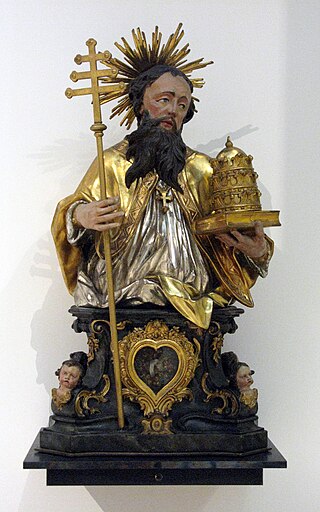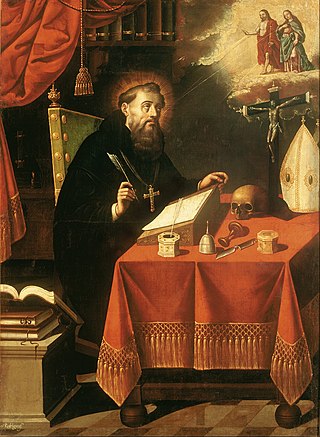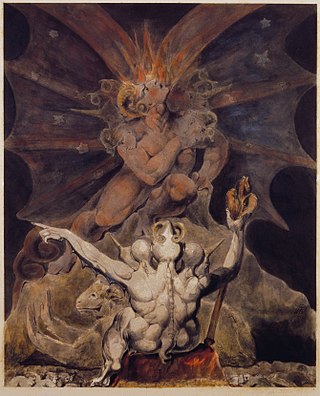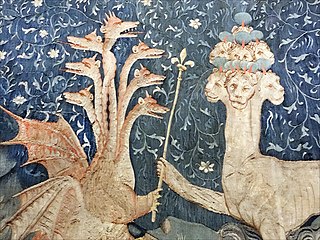Related Research Articles

The Book of Revelation or Book of the Apocalypse is the final book of the New Testament. Written in Koine Greek, its title is derived from the first word of the text: apokalypsis, meaning 'unveiling' or 'revelation'. The Book of Revelation is the only apocalyptic book in the New Testament canon. It occupies a central place in Christian eschatology.
Christian eschatology is a minor branch of study within Christian theology which deals with the doctrine of the "last things", especially the Second Coming of Christ, or Parousia. Eschatology – the word derives from two Greek roots meaning "last" (ἔσχατος) and "study" (-λογία) – involves the study of "end things", whether of the end of an individual life, of the end of the age, of the end of the world, or of the nature of the Kingdom of God. Broadly speaking, Christian eschatology focuses on the ultimate destiny of individual souls and of the entire created order, based primarily upon biblical texts within the Old and New Testaments. Christian eschatology looks to study and discuss matters such as death and the afterlife, Heaven and Hell, the Second Coming of Jesus, the resurrection of the dead, the rapture, the tribulation, millennialism, the end of the world, the Last Judgment, and the New Heaven and New Earth in the world to come.

Pope Linus was the bishop of Rome from c. AD 67 to his death. He is generally regarded as the second Bishop of Rome, after St. Peter. As with all the early popes, he was canonized.

Preterism is a Christian eschatological view or belief that interprets some or all prophecies of the Bible as events which have already been fulfilled in history. This school of thought interprets the Book of Daniel as referring to events that happened from the seventh century BC until the first century AD, while seeing the prophecies of the Book of Revelation, as well as Christ's predictions within the Olivet Discourse, as events that happened in the first century AD. Preterism holds that Ancient Israel finds its continuation or fulfillment in the Christian church at the destruction of Jerusalem in AD 70.
In Christian eschatology, the Great Tribulation is a period mentioned by Jesus in the Olivet Discourse as a sign that would occur in the time of the end.

The 1st century was the century spanning AD 1 through AD 100 (C) according to the Julian calendar. It is often written as the 1st century AD or 1st century CE to distinguish it from the 1st century BC which preceded it. The 1st century is considered part of the Classical era, epoch, or historical period. The Roman Empire, Han China and the Parthian Persia were the most powerful and hegemonic states.

The 90s was a decade that ran from January 1, AD 90, to December 31, AD 99.
Premillennialism, in Christian eschatology, is the belief that Jesus will physically return to the Earth before the Millennium, heralding a literal thousand-year messianic age of peace. Premillennialism is based upon a literal interpretation of Revelation 20:1–6 in the New Testament, which describes Jesus's reign in a period of a thousand years.
Cerinthus was an early Gnostic, who was prominent as a heresiarch in the view of the early Church Fathers. Contrary to the Church Fathers, he used the Gospel of Cerinthus, and denied that the Supreme God made the physical world. In Cerinthus' interpretation, the Christ descended upon Jesus at baptism and guided him in ministry and the performing of miracles, but left him at the crucifixion. Similarly to the Ebionites, he maintained that Jesus was not born of a virgin, but was a mere man, the biological son of Mary and Joseph.

The authorship of the Johannine works has been debated by biblical scholars since at least the 2nd century AD. The debate focuses mainly on the identity of the author(s), as well as the date and location of authorship of these writings.

Amillennialism or amillenarism is a chillegoristic eschatological position in Christianity which holds that there will be no millennial reign of the righteous on Earth. This view contrasts with both postmillennial and, especially, with premillennial interpretations of Revelation 20 and various other prophetic and eschatological passages of the Bible.

The post-tribulation rapture doctrine is the belief in a combined resurrection and rapture, or gathering of the saints, after the Great Tribulation.
Kenneth L. Gentry Jr. is a Reformed theologian, and an ordained minister in the Reformed Presbyterian Church General Assembly. He is particularly known for his support for and publication on the topics of orthodox preterism and postmillennialism in Christian eschatology, as well as for theonomy and Young Earth creationism. He holds that each of these theological distinctives are logical and theological extensions of his foundational theology.

The Seven Seals of God from the Bible's Book of Revelation are the seven symbolic seals that secure the book or scroll that John of Patmos saw in an apocalyptic vision. The opening of the seals of the document occurs in Rev Ch 5–8 and marks the Second Coming of the Christ and the beginning of The Apocalypse/Revelation. Upon the Lamb of God/Lion of Judah opening a seal on the cover of the book/scroll, a judgment is released or an apocalyptic event occurs. The opening of the first four Seals releases the Four Horsemen, each with his own specific mission. The opening of the fifth Seal releases the cries of martyrs for the "Word/Wrath of God". The sixth Seal prompts plagues, storms and other cataclysmic events. The seventh Seal cues seven angelic trumpeters who in turn cue the seven bowl judgments and more cataclysmic events.

The First Epistle of Clement is a letter addressed to the Christians in the city of Corinth. The work is attributed to Clement I, the fourth bishop of Rome and almost certainly written by him. Based on internal evidence some scholars say the letter was composed some time before AD 70, but the common time given for the epistle's composition is at the end of the reign of Domitian. It ranks with Didache as one of the earliest, if not the earliest, of extant Christian documents outside the traditional New Testament canon. As the name suggests, a Second Epistle of Clement is known, but this is a later work by a different author. Part of the Apostolic Fathers collection, 1 and 2 Clement are not part of the canonical New Testament.

The number of the beast is associated with the Beast of Revelation in chapter 13, verse 18 of the Book of Revelation. In most manuscripts of the New Testament and in English translations of the Bible, the number of the beast is six hundred sixty-six or χξϛ. Papyrus 115, as well as other ancient sources like Codex Ephraemi Rescriptus, give the number of the beast as χιϛ or χιϲ, transliterable in Arabic numerals as 616, not 666; critical editions of the Greek text, such as the Novum Testamentum Graece, note χιϛ/616 as a variant.

The Beast may refer to one of three beasts described in the Book of Revelation. Revelation 12 describes a series of wars. First, the dragon opposes "a woman clothed with the sun," then her male child, then Michael and his angels in heaven, then again the woman, and, lastly, the dragon goes away to make war against her other children. In each of the wars, the dragon is defeated. Revelation 13 begins with the dragon standing on the seashore, apparently waiting for reinforcements. From that vantage point, he is joined by two helpers; the beast from the sea and the beast from the earth.

Apocalypse or The Apocalypse is a biblical telefilm produced for European television released in 2002 starring Richard Harris and co-starring Bruce Payne.

Saint Peter, also known as Peter the Apostle, Simon Peter, Simeon, Simon, or Cephas, was one of the Twelve Apostles of Jesus Christ and one of the first leaders of the early Christian Church. He appears repeatedly and prominently in all four New Testament gospels as well as the Acts of the Apostles. Catholic tradition accredits Peter as the first bishop of Rome—or pope—and also as the first bishop of Antioch.

The name John is prominent in the New Testament and occurs numerous times. Among Jews of this period, the name was one of the most popular, borne by about five percent of men. Thus, it has long been debated which Johns are to be identified with which.
References
- 1 2 3 4 Book Review: Before Jerusalem Fell: Dating the Book of Revelation (An Exegetical and Historical Argument for a Pre-AD. 70 Composition), by Kenneth L. Gentry, Jr., Th.D. Reviewed by the Rev. Grover E. Gunn, III, pastor, the Carrollton Presbyterian Church (PCA), Carrollton, Mississippi. Counsel of Chalcedon Magazine, March 1990, Issue 2, pp. 22–23.
- ↑ Gregg, Steve, ed. (1997). Revelation, four views: a parallel commentary. T. Nelson Publishers. pp. 14–18. ISBN 0840721285.